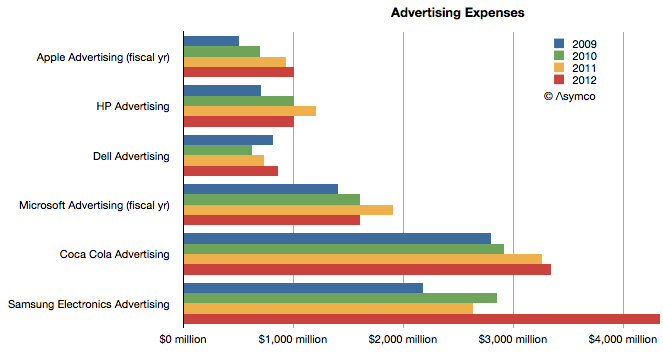Diagnosing Apple’s Wall Street woes has become a bit of a cottage industry, prompting some to crown the consumer tech giant a has-been, while other observers point to a resurgent future. Earlier this month, a Forbes business contributor took a shot, claiming South Korea’s Samsung has overtaken Apple using the iPhone maker’s own weapon: promotion.
After knocking out music giant Sony with the iPod, using the iPhone to drive BlackBerry to the fringes and destroying the PC market with the iPad, Apple is “milking” its hard-won gains. Meanwhile, Samsung has plowed revenue back into promotion, outspending Apple by more than four-to-one. Ad attack coupled with Samsung’s much wider footprint helped the Galaxy maker to change the game on Apple…
If the tech game were only about products and features and which company best delivered them, Apple would still be riding high, still described as ‘having a lock’ on the mobile industry.
“Samsung did not change the game with technology or product,” writes Adam Hartung for Forbes.
The resilient firm is using the same Android other non-Apple players used to build upon. And, its Galaxy is comparable, but not superior to the iPhone.
Instead, Samsung changed the game by focusing on distribution and advertising, Samsung did not change the game with technology or product.
It has used the same Android starting point as most competitors for phones and tablets. Its products are comparable to Apple’s – but not dramatically superior.
And while they are cheaper, in most instances that has not been the reason people bought Galaxies, Notes, Tabs and S phones.
At a time when Apple was selling boatloads of products, Tim Cook & Co. cut Apple’s promotional budget, listed under as “Selling, General and Administrative” spending. The percentage went from fourteen percent of Apple revenue in 2006 to just five percent in 2012.
By contrast, Samsung increased its promotional spending to fifteen percent.
Advertising expenses of some of the biggest brands, via Asymco.
At one point in 2009, the figure even rose to an unheard-of 25 percent of revenue. This means Samsung was spending on advertising approximately one out of each four dollars earned.
Indeed, the former ‘Think Different’ ad man Ken Segall recently tried to explain why Samsung has successfully become the anti-Apple company:
Samsung continues to bash away at Apple, delivering ads that are well produced, well written, and seem to be striking a nerve. In contrast to Apple, which has been sticking to its product-based ads, Samsung has been scoring points with its people-based ads – most of which play off some growing negative perceptions about Apple.
Here’s a funny fan-made take on Samsung’s anti-iPhone newspaper ad.
Along with slashing the revenue going to promote its products, Apple maintained its limited distribution, although recent launches have featured wider availability of iDevices.
The iPhone 5 is a good example: the handset is available on 240 different carriers whereas Galaxy devices are available from hundreds of telcos around the globe.
In fact, Apple has vastly increased its efforts in India, expected to become the next China in terms of revenue potential
The writer sums up:
Some now recognize Apple is vulnerable, and think its best times are behind it. And it’s all because Samsung ignored the industry lock-in to constantly focusing on the product, and instead changed the game on Apple.
Neither Apple nor its CEO Tim Cook got where they are today by being asleep at the wheel.
The company is expected to announce a number of products, including some designed to mitigate Samsung’s price advantage.
Just recently, Apple has also shown movement on refurbishing its image, unveiling the “Why iPad?” and “Why iPhone?” promotional campaigns designed to counteract rivals.
But will it be enough?


